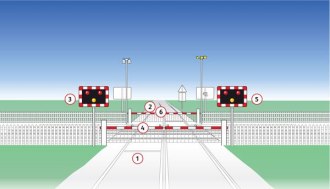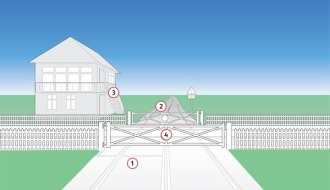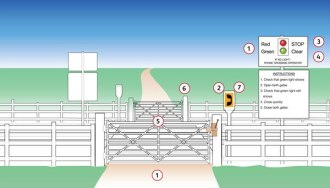Depending on where in the UK you’re learning to drive, you may have to tackle level crossings during a driving lesson. Even if you don’t learn to drive near a level crossing, you’re going to encounter them sooner or later, and they may also crop up in your theory test. So it’s well worth learning the basics.
What are level crossings?
A level crossing (known as a railway crossing in the USA) is an area where roads/footpaths and rail tracks cross each other. There are over 6,500 level crossings in the UK, roughly 1,500 of which are road crossings. There are several distinct types of level crossings but new ones are seldom built; safety concerns mean that bridges and tunnels are considered better options.
Are level crossings dangerous
The crossings themselves are not particularly dangerous if you know how to safely use them. Network Rail claim that “over 90% of the risk in the previous five years has resulted from user misuse in the form of error or abuse.”
How do I use a level crossing
As we’ve mentioned, there are several types of level crossing in the UK and each one is used differently. We’ll explain each type individually to make sure that you’re ready to deal with your local level crossing, no matter what kind it is.
Barrier crossings
When you think of a level crossing, it’s probably a barrier crossing that you imagine. These particular crossings feature automatic barriers, sometimes covering the entire width of the road and sometimes covering one side of the road each. They’re the most common level crossings in the UK and require very little interaction from you as a road user.
When a train gets close to the crossing, the amber light on the crossing signs will show, shortly followed by flashing red lights and an audible siren or alarm. If you see the lights, stop at the white line. Do not, any any circumstances, see the lights as an invitation to try to race across the crossing to avoid waiting.

If you approach an automatic barrier level crossing, follow these steps:
- Drive up to the crossing and be ready to stop behind the white line if necessary.
- If you’re going to drive across the crossing, make sure that your exit is clear; you really don’t want to get stuck on the tracks.
If the amber light is on or the red lights are flashing, you must stop behind the white line, even if you think you’ve got enough time to make it across.
If the front of your vehicle has already crossed the white line when the amber light turns on, just keep going. Do not stop on the tracks. Ever.
- If the red lights continue to flash after a train has passed, it means that another one is coming. Wait for it to pass.
- Cross the crossing when the barriers are completely raised and the red/amber lights turn off.
Gated crossing operated by railway staff
Dealing with this type of level crossing is very, very easy; the railway staff do pretty much all of the work for you. If a train is coming, railway staff will close the gates. If you’re free to cross the tracks, the gates will be open. Unless you crash through the gates or try to nip past the staff while they’re closing them (a terrible idea), you’ll be fine.

When approaching a gated crossing operated by railway staff, follow these steps:
- Drive up to the crossing and be ready to stop behind the white line if necessary.
- Make sure that your exit is clear before you enter the crossing.
- If a train is coming, a member of railway staff will close the gates. You don’t need to help them with the gate.
- After the train has passed, the employee will open the gates. If they seem to be waiting a long time, it probably means another train is on the way. Do not tamper with the gates.
User-operated crossing
This particular type of level crossing requires the most attention from drivers and should be treated with respect. They sometimes have telephones or warning lights on them, but not always. If you approach a user-operated crossing, be sure to take a moment to understand how to use it.

When approaching a user-operated crossing, follow these steps:
- Stop. If stop lights are present, check that they are working. If they are not, contact railway staff and do what they tell you. If there are no stop lights or telephone on the crossing, then look both ways and listen carefully for a train. If nothing is coming then open gates on both sides of the railway and cross quickly. Once you’re safely over the crossing, exit your vehicle, check for trains again, and close the gates. Never leave them open.
- If a telephone is present, use it to get permission to cross if you’re travelling in a large or slow vehicle or are crossing with animals.
- If stop lights are present, you must not cross when the red light is on. If it stays on after a train has passed, it means another one is coming. Do not attempt to cross while the red light is on, wait for the green one.
- When the green light is on, look and listen for trains and, if it’s safe, open gates on both sides of the crossing.
- If the green lights are still on, enter your vehicle and cross quickly. Never stop on the tracks.
- Check that the green light is still on. If it is, close the gates behind you. Never leave them open.
- If you used the phone to contact railway staff, they may ask you to call back when you’re finished. If so, make sure you call them back.
Open level crossings
Open level crossings have no barriers, gates or attendant railway employees. They always have signs and some have lights and audible alarms and have a give way line rather than a stop line at the entrance.
Open level crossings are quite uncommon and are usually found on very quiet country roads with minimal traffic. Always approach an open level crossing with great care.
When approaching an open level crossing, follow these steps:
- Approach the crossing carefully, being ready to stop behind the line if necessary.
- Before entering the crossing, make sure that your exit is clear. If no lights are present, look and listen for trains and, if the way is clear, cross quickly, making sure you don’t stop on the tracks.3.
- If lights are present and the amber light is on or the red lights are flashing, wait at the white line.
- If you’ve already started crossing when the lights come on, keep going. Never stop on the tracks.
- If the red light keeps flashing after a train has passed, it means another train is coming. Wait for it to pass. Do not attempt to quickly cross in-between trains.
- Only cross when the red and amber lights are off.
- Images via Network Rail, a fantastic resource if you want to know more about level crossings.